Connect With Us
Blog
Items filtered by date: September 2025
How Does a Blister Form?
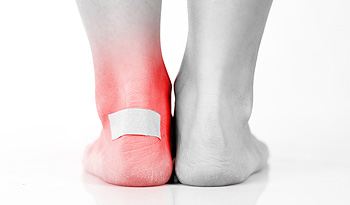 Blisters that develop on the feet can make it difficult to walk and complete daily activities. When the skin is irritated, the body’s natural healing response is to protect the damaged area by forming a small bubble over it that is filled with fluid. As new skin develops, the blister will gradually drain, and is no longer needed. Blisters generally develop from excess friction that is caused by wearing shoes or socks that do not fit correctly. Additional reasons why they can form can come from existing medical conditions such as psoriasis and eczema. Effective prevention techniques can include wearing comfortable shoes, checking the feet for signs of rubbing, and removing the shoes if discomfort is felt. If you would like additional information about how to treat and prevent blisters, please consult with a podiatrist.
Blisters that develop on the feet can make it difficult to walk and complete daily activities. When the skin is irritated, the body’s natural healing response is to protect the damaged area by forming a small bubble over it that is filled with fluid. As new skin develops, the blister will gradually drain, and is no longer needed. Blisters generally develop from excess friction that is caused by wearing shoes or socks that do not fit correctly. Additional reasons why they can form can come from existing medical conditions such as psoriasis and eczema. Effective prevention techniques can include wearing comfortable shoes, checking the feet for signs of rubbing, and removing the shoes if discomfort is felt. If you would like additional information about how to treat and prevent blisters, please consult with a podiatrist.
Blisters are prone to making everyday activities extremely uncomfortable. If your feet are hurting, contact Jeffrey Rosenblatt, DPM of New York. Our doctor can provide the care you need to keep you pain-free and on your feet.
Foot Blisters
Foot blisters develop as a result of constantly wearing tight or ill-fitting footwear. This happens due to the constant rubbing from the shoe, which can often lead to pain.
What Are Foot Blisters?
A foot blister is a small fluid-filled pocket that forms on the upper-most layer of the skin. Blisters are filled with clear fluid and can lead to blood drainage or pus if the area becomes infected.
How Do Blisters Form?
Blisters on the feet are often the result of constant friction of skin and material, usually by shoe rubbing. Walking in sandals, boots, or shoes that don’t fit properly for long periods of time can result in a blister. Having consistent foot moisture and humidity can easily lead to blister formation.
Prevention & Treatment
It is important to properly care for the affected area in order to prevent infection and ease the pain. Do not lance the blister and use a Band-Aid to provide pain relief. Also, be sure to keep your feet dry and wear proper fitting shoes. If you see blood or pus in a blister, seek assistance from a podiatrist.
If you have any questions, please feel free to contact our office located in Brooklyn, NY . We offer the newest diagnostic and treatment technologies for all your foot care needs.
Systemic Sclerosis and Its Impact on Feet
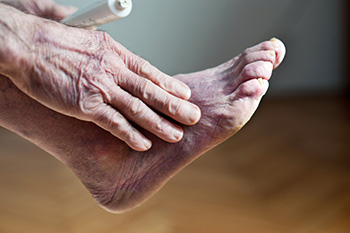
Color changes in the feet, such as redness, blue tones, or pale patches, can be an early indicator of autonomic involvement in systemic sclerosis, a rare autoimmune disorder. Systemic sclerosis affects blood flow by tightening blood vessels and altering circulation, which can cause noticeable color shifts in response to temperature or stress. Feet may appear blue due to reduced oxygen, red with increased blood flow, or pale when circulation is restricted. These color changes may also come with symptoms like numbness, tingling, or sensitivity to cold, signaling an underlying problem with the autonomic nervous system, which regulates involuntary functions, including blood vessel dilation. If you have this condition and it affects your feet, it is strongly suggested that you visit a podiatrist to manage symptoms and prevent complications. These foot specialists can assess circulation, suggest protective strategies for temperature changes, and work with other specialists to ensure proper blood flow and nerve function, ultimately helping to maintain foot health.
Some foot conditions may require additional professional care. If you have any concerns, contact Jeffrey Rosenblatt, DPM of New York. Our doctor can provide the care you need to keep you pain-free and on your feet.
Rare Foot Conditions
The majority of foot conditions are common and can be treated by a podiatrist. Standard diagnostic procedures are generally used to identify specific conditions and treatment can be rendered. A podiatrist also treats rare foot conditions which can be difficult to diagnose and may need extra attention and care.
There are many rare foot conditions that can affect children. Some of these can include:
- Freiberg’s disease
- Kohler’s disease
- Maffucci syndrome
Freiberg’s disease - This can be seen as a deterioration and flattening of a metatarsal bone that exists in the ball of the foot. It typically affects pre-teen and teenage girls, but can affect anyone at any age. Symptoms that can accompany this can be swelling, stiffness, and the patient may limp.
Kohler’s disease - This often targets the bone in the arch of the foot and affects younger boys. It can lead to an interruption of the blood supply which ultimately can lead to bone deterioration. The patient may limp or experience tenderness, swelling, and redness.
Maffucci syndrome - This affects the long bones in a child’s foot leading to the development of abnormal bone lesions. They are benign growths and typically develop in early childhood and the bones may be susceptible to breaking.
A podiatrist can properly diagnose and treat all types of rare foot conditions. If your child is affected by any of these symptoms or conditions, please don’t hesitate to call our office so the correct treatment method can begin.
If you have any questions, please feel free to contact our office located in Brooklyn, NY . We offer the newest diagnostic and treatment technologies for all your foot care needs.
Signs That You May Have Plantar Fasciitis
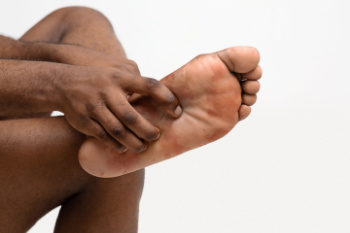
Plantar fasciitis is one of the most common causes of heel pain, and develops when the thick band of tissue that supports the arch becomes strained at its attachment to the heel bone. A key sign of plantar fasciitis is sharp pain under the heel when first standing in the morning or after sitting for a while. This pain may ease briefly, but often returns as the day goes on. It can also intensify during the push-off phase of walking or running when the heel lifts from the ground. Some people describe aching, burning, or stabbing sensations along the arch or inner border of the heel. Mild swelling or tenderness at the bottom of the foot can also occur. A podiatrist can examine the foot, review risk factors, and recommend effective treatment options. If you are experiencing symptoms of plantar fasciitis, it is suggested that you schedule an appointment with a podiatrist for an evaluation and appropriate treatment.
Plantar fasciitis can be very painful and inconvenient. If you are experiencing heel pain or symptoms of plantar fasciitis, contact Jeffrey Rosenblatt, DPM from New York. Our doctor can provide the care you need to keep you pain-free and on your feet.
What Is Plantar Fasciitis?
Plantar fasciitis is the inflammation of the thick band of tissue that runs along the bottom of your foot, known as the plantar fascia, and causes mild to severe heel pain.
What Causes Plantar Fasciitis?
- Excessive running
- Non-supportive shoes
- Overpronation
- Repeated stretching and tearing of the plantar fascia
How Can It Be Treated?
- Conservative measures – anti-inflammatories, ice packs, stretching exercises, physical therapy, orthotic devices
- Shockwave therapy – sound waves are sent to the affected area to facilitate healing and are usually used for chronic cases of plantar fasciitis
- Surgery – usually only used as a last resort when all else fails. The plantar fascia can be surgically detached from the heel
While very treatable, plantar fasciitis is definitely not something that should be ignored. Especially in severe cases, speaking to your doctor right away is highly recommended to avoid complications and severe heel pain. Your podiatrist can work with you to provide the appropriate treatment options tailored to your condition.
If you have any questions, please feel free to contact our office located in Brooklyn, NY . We offer the newest diagnostic and treatment technologies for all your foot care needs.
Common Reasons for Ingrown Toenails
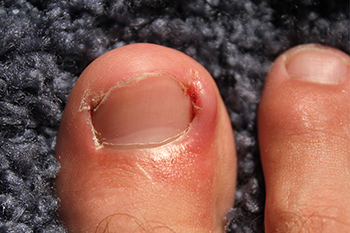
Ingrown toenails occur when the edge of the nail grows into the surrounding skin, often causing pain and discomfort. The big toe is most commonly affected, and risk factors include improper trimming of the toenails, especially when nails are cut too short or rounded at the edges. Wearing tight shoes that crowd the toes or frequent use of flip-flops, which allow too much motion and pressure, may also contribute. People with naturally curved or thickened toenails, as well as those with toe deformities or excessive foot sweating, are more prone to this problem. Ingrown toenails may lead to swelling, redness, infection, and difficulty walking, if not addressed promptly. A podiatrist can evaluate the severity of the condition, provide treatment to relieve pain, and, in advanced cases may perform surgery to correct the nail growth pattern. If you are experiencing pain from an ingrown toenail, it is suggested that you schedule an appointment with a podiatrist for effective treatment.
Ingrown toenails may initially present themselves as a minor discomfort, but they may progress into an infection in the skin without proper treatment. For more information about ingrown toenails, contact Jeffrey Rosenblatt, DPM of New York. Our doctor can provide the care you need to keep you pain-free and on your feet.
Ingrown Toenails
Ingrown toenails are caused when the corner or side of a toenail grows into the soft flesh surrounding it. They often result in redness, swelling, pain, and in some cases, infection. This condition typically affects the big toe and may recur if it is not treated properly.
Causes
- Improper toenail trimming
- Genetics
- Improper shoe fitting
- Injury from pedicures or nail picking
- Abnormal gait
- Poor hygiene
You are more likely to develop an ingrown toenail if you are obese, have diabetes, arthritis, or have any fungal infection in your nails. Additionally, people who have foot or toe deformities are at a higher risk of developing an ingrown toenail.
Symptoms
Some symptoms of ingrown toenails are redness, swelling, and pain. In rare cases, there may be a yellowish drainage coming from the nail.
Treatment
Ignoring an ingrown toenail can have serious complications. Infections of the nail border can progress to a deeper soft-tissue infection, which can then turn into a bone infection. You should always speak with your podiatrist if you suspect you have an ingrown toenail, especially if you have diabetes or poor circulation.
If you have any questions, please feel free to contact our office located in Brooklyn, NY . We offer the newest diagnostic and treatment technologies for all your foot care needs.
Why Women Are More Prone to Bunions
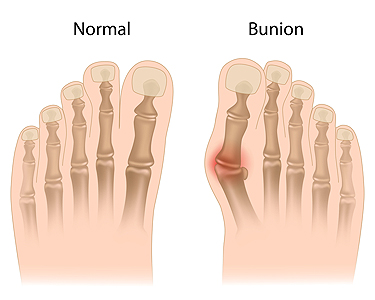
Bunions are bony bumps that form at the base of the big toe, and women are more likely to develop them due to footwear choices and genetic factors. Narrow or high-heeled shoes with a pointed toe box can place excess pressure on the front of the foot, leading to misalignment over time. Symptoms include pain, swelling, redness, and difficulty wearing certain shoes. Risk factors include a family history of bunions, flat feet, and conditions such as like arthritis. A podiatrist can provide relief through customized footwear advice, orthotics, and, when necessary, surgical correction. If you are experiencing discomfort from bunions, it is suggested that you visit a podiatrist who can offer effective relief and management tips.
If you are suffering from bunions, contact Jeffrey Rosenblatt, DPM of New York. Our doctor can provide the care you need to keep you pain-free and on your feet.
What Is a Bunion?
A bunion is formed of swollen tissue or an enlargement of boney growth, usually located at the base joint of the toe that connects to the foot. The swelling occurs due to the bones in the big toe shifting inward, which impacts the other toes of the foot. This causes the area around the base of the big toe to become inflamed and painful.
Why Do Bunions Form?
Genetics – Susceptibility to bunions are often hereditary
Stress on the feet – Poorly fitted and uncomfortable footwear that places stress on feet, such as heels, can worsen existing bunions
How Are Bunions Diagnosed?
Doctors often perform two tests – blood tests and x-rays – when trying to diagnose bunions, especially in the early stages of development. Blood tests help determine if the foot pain is being caused by something else, such as arthritis, while x-rays provide a clear picture of your bone structure to your doctor.
How Are Bunions Treated?
- Refrain from wearing heels or similar shoes that cause discomfort
- Select wider shoes that can provide more comfort and reduce pain
- Anti-inflammatory and pain management drugs
- Orthotics or foot inserts
- Surgery
If you have any questions, please feel free to contact our office located in Brooklyn, NY . We offer the newest diagnostic and treatment technologies for all your foot care needs.
Blog Archives
- October 2025
- September 2025
- August 2025
- July 2025
- June 2025
- May 2025
- April 2025
- March 2025
- February 2025
- January 2025
- December 2024
- November 2024
- October 2024
- September 2024
- August 2024
- July 2024
- June 2024
- May 2024
- April 2024
- March 2024
- February 2024
- January 2024
- December 2023
- November 2023
- October 2023
- September 2023
- August 2023
- July 2023
- June 2023
- May 2023
- April 2023
- March 2023
- February 2023
- January 2023
- December 2022
- November 2022
- October 2022
- September 2022
- August 2022
